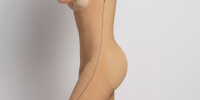LOL Jer

I am positive



it is a different kind

Your comment sent me on a little search regarding another item in the gaucho apparel called "bombacha", the baggy pants we see them wearing in some pictures and illustrations.
Now "bombacha" in modern day Argentine Spanish also refers to women underwear, hence my brain trying to relate to your earlier comment lol
It turns out that the "Bombacha" came a bit later in the history of gaucho apparel.
Up until the 1860's or so gauchos wore what is called a
"chiripá", a rectangular piece of cloth held at the waist by the "faja" over the "calzoncillo", a sort of long underwear pants.
"Chiripá"
From what I have been reading the
"bombacha" has its origin in the Crimean War around 1856. A terrible war that killed hundreds of thousands of Turks, Russians, French and British soldiers.
After the war, a French diplomat offered to the government of Argentina about 100,000 Turk uniform pants or "babuchas turcas" . The president of Argentina at the time, Justo José de Urquiza accepted the offer and distributed the "bombachas" by the thousands to rural workers.
The new apparel was liked so much that it slowly replaced the "Chiripá"
Turkish soldier/Argentine gaucho
"Chiripá" and "Bombacha"
"Bombacha"
A "modern day" gaucho
Yes, that's right Jer ! Funny thing how when knife nuts look at art we pick up right away on these details

I guess the painter did not have much of an imagination when it came to knives.
The depictions in the painting may be a facones although the facon and daga are very similar.
Dagas are double edged and facones single edge with a double guard.
Here is an illustration from
Mr. Domenech's essay
That painting looks to me a depiction of the epic poem
"The Gaucho Martin Fierro".
In the first book Martin Fierro kills a man in a knife duel.
In the second book, an older and wiser Martin Fierro tries to reintegrate into society and correct his ways.
The books ends with a
"Payada" , a form of sung poetry where gauchos would "compete to produce the most eloquent verse, each answering questions posed by the other, often insulting."
It is then revealed that the brother of the person slain in the first book is now facing Martin Fierro.
"At the end, Fierro speaks of changing his name and living in peace, but it is not entirely clear that the duel has been avoided"
I printed Mr Domenech essay to have it handy for easier reference
The essay can be found here:
Historic setting and classification of the types of traditional South American knives and daggers and parallels with the Bowie knife
www.vikingsword.com
CelloDan , I have an old silver Loony to help you get started.































